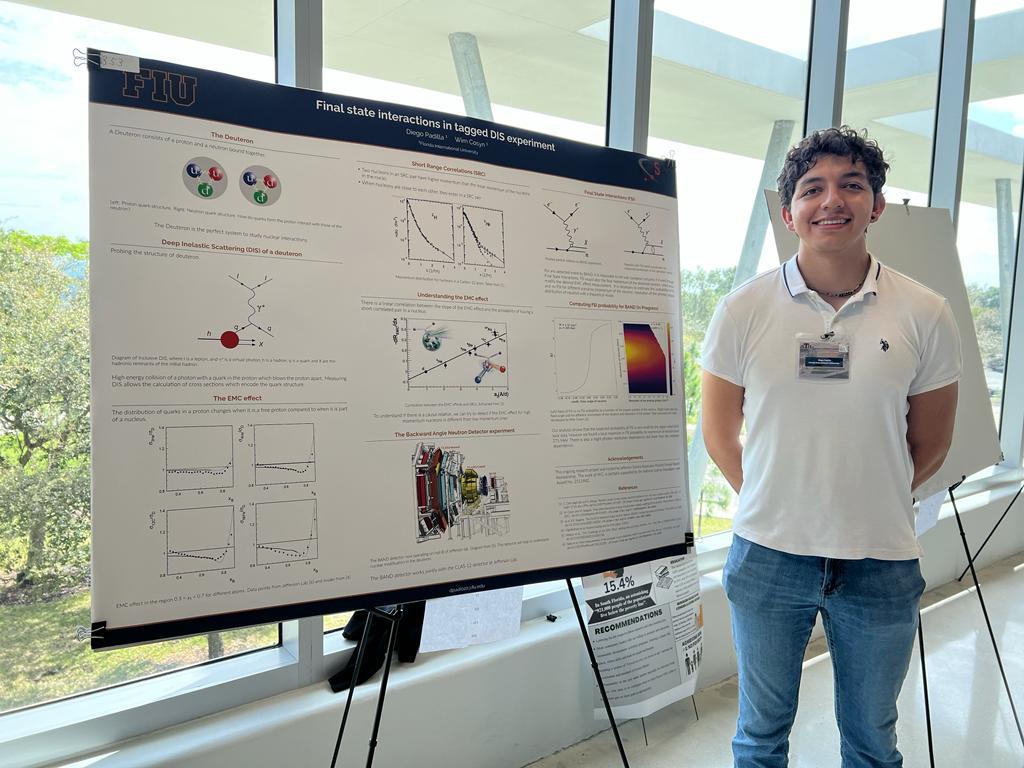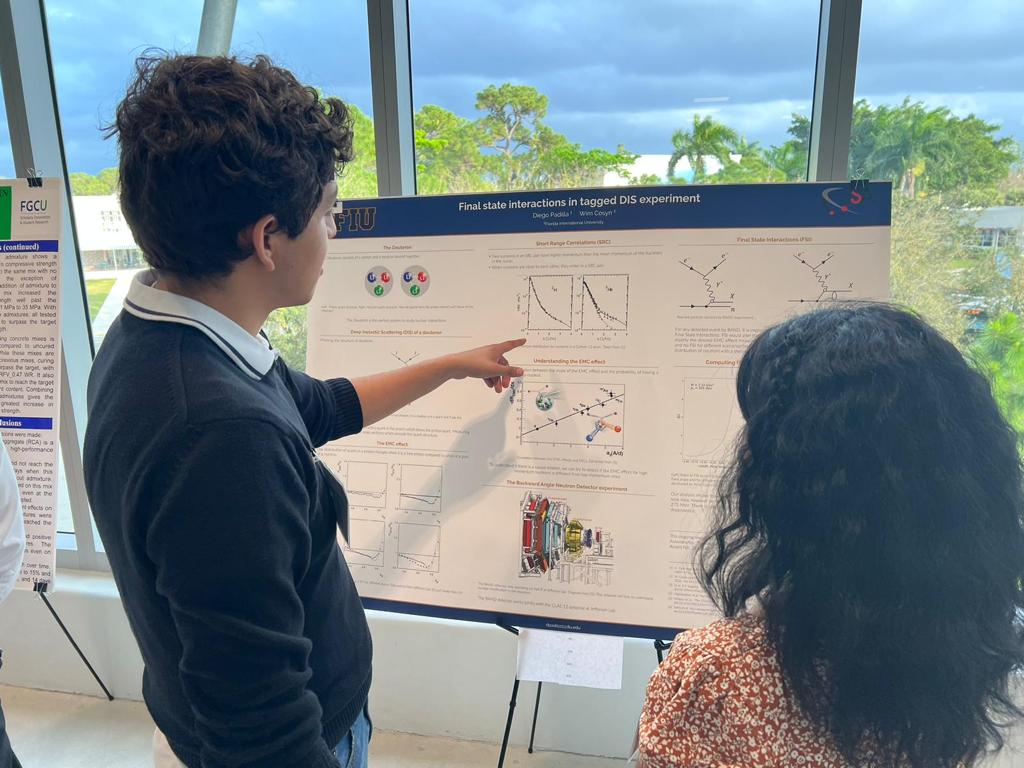As a 2022-2023 Jefferson Science Associates Minority/Female Undergraduate Research Assistantship recipient, Diego Padilla Monroy is helping fellow physicists pick out misleading neutrons
A quark is always found with other quarks. Similarly, Diego Padilla Monroy has always been drawn to hang out with other physicists. In high school, after he realized physics was a way to apply his favorite subject, math, to the real world, he started meeting with like-minded friends to talk about it.
Now, as a senior majoring in physics at Florida International University, he gathers weekly with a group of undergraduates, graduate students, and professors to discuss and explore nuclear physics theory. Participants are welcome to give presentations on any topic; Padilla Monroy has delivered one about dark matter.
“I think it’s cool, because it’s this environment where students doing research with different professors can meet up and talk and help each other,” he said. “We get to explore other research projects and it sparks research relationships.”
Recently, Padilla Monroy joined another community, the U.S. Department of Energy’s Thomas Jefferson National Accelerator Facility, as one of two 2022-2023 Jefferson Science Associates Minority/Female Undergraduate Research Assistantship (M/FURA) recipients.
“It's exciting to win this award,” Padilla Monroy said. “I knew there was a very small chance of getting in because there’s only two, but I applied anyway.”
Alone versus together
For his assistantship project, Padilla Monroy is helping analyze data from the Backward Angle Neutron Detector (BAND) experiment, which recently finished collecting data at Jefferson Lab.
The goal of BAND is to study the EMC effect, a phenomenon in which the distribution of quarks that make up a free proton or neutron is different from the distribution of quarks that make up a proton or neutron inside of a composite atomic nucleus. (Its name comes from the European Muon Collaboration at CERN that discovered it in the 1980s.)
“This EMC effect has been studied a lot, and they saw that it’s correlated to another phenomenon, which is called short-range correlations,” Padilla Monroy said.
Short-range correlations occur when two protons or neutrons (collectively called nucleons) in a nucleus get too close to each other, and their repulsion causes them to have a higher momentum.
BAND seeks to further investigate the relationship between short-range correlations and the EMC effect. Its data will ultimately help physicists better understand the strong force responsible for holding quarks together to form nucleons, and why this force alters quark distribution depending on a nucleon’s surroundings.
The experiment used electrons from Jefferson Lab’s Continuous Electron Beam Accelerator Facility (CEBAF), a DOE user facility. It shot the electrons at deuteron nuclei, which consist of one proton and one neutron. When an electron hits the deuteron, it breaks the proton apart and ejects the neutron. Measuring properties of the ejected neutron allows physicists to access information about the proton’s quark distribution in this composite particle, which they can then compare to a free proton to learn more about the EMC effect.
Hunting for neutrons in disguise
To ensure the nucleons being probed are also part of a short-range-correlated pair, BAND focuses on neutrons that have a high momentum. However, some high-momentum neutrons are not created by short-range correlations. Some of them are dupes.
For instance, particle remnants from a broken proton can hit an ejected neutron, causing it to have a higher momentum.
“And then what you would measure as a high-momentum neutron that you thought was from a short-range-correlated pair is actually just a low momentum neutron that was hit by some remnant of the proton,” said Padilla Monroy, who is hunting for these disguised neutrons. “My work addresses this subtlety.”
Using a lot of coding, he’s running BAND’s data through a model that calculates the probability of these dupe-making interactions occurring after a collision.
“These calculations are essential to disentangle how much the quark structure of the bound proton in the deuteron is modified from that of a free proton, which is what the BAND experiment is after,” said Wim Cosyn, an assistant professor of physics at FIU.
Cosyn developed the model Padilla Monroy is using for his project with Misak Sargsian, another professor of physics at FIU. Padilla Monroy met Cosyn when he started attending the nuclear theory physics meetings.
“From our interactions then, it was clear he's a motivated and bright student, so when the M/FURA call arrived in my mailbox, I immediately thought of him,” said Cosyn, who nominated Padilla Monroy for this assistantship. “It would give him the opportunity to work on a specific project and would be helpful for future applications. The financial support also never hurts, of course. These things do make a difference!”
Representation matters
Padilla Monroy is inspired by Cosyn, who showed him the extensive code repository for the different models he’s developed during his career.
“My professors have gone through the pipeline, and they've done so much research,” said Padilla Monroy. “It’s pretty interesting to see what you can do in the future if you keep working on this.”
Although Padilla Monroy will be focusing on nuclear physics for his assistantship project, he completed two National Science Foundation Research Experiences for Undergraduates programs that piqued his interest in other fields. In 2021, he studied fluid dynamics at the University of Chicago. Last summer, he lived in Italy for two months while investigating gravitational waves.
“All of my research experiences so far have made me want to continue doing research,” he said.
For graduate school next year, Padilla Monroy is mostly interested in pursuing theoretical nuclear physics, but he also applied to study gravitational waves and fluid dynamics. After graduate school, he hopes to conduct research while teaching as a full-time professor.
“Almost all my peers are Latino like me, but we don't see that in the professors,” he said.
This is one aspect of his research experiences that he wants to change for future students.
“My school is supposed to represent Hispanics, but we're not really doing it on all levels. And that's something that I would like to do for myself,” he said.
The assistantship is supported by the JSA Initiatives Fund Program. The Initiatives Fund is supported by Jefferson Science Associates, which manages and operates Jefferson Lab for DOE’s Office of Science. Initiatives Fund activities further the scientific outreach, and promote the science, education and technology missions of Jefferson Lab.
Further Reading
Particles Pick Pair Partners Differently in Small Nuclei
Investigating an Imbalanced Universe
Music Major Finds a New Rhythm in Physics
Student’s Flexibility Leads Toward Greater Mobility for Others
Lifelong Exposure to Science Leads to Career in Physics
By Chris Patrick
Contact: Kandice Carter, Jefferson Lab Communications Office, kcarter@jlab.org



